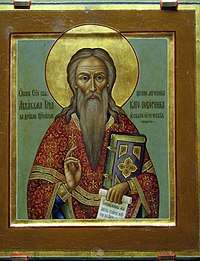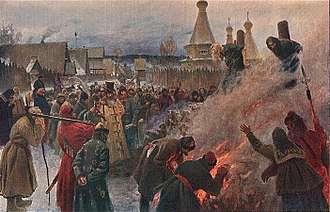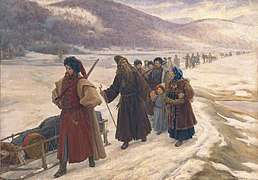Avvakum
Avvakum Petrov (Russian: Авва́кум Петро́в; November 20, 1620/21 – April 14, 1682) was a Russian protopope of the Kazan Cathedral on Red Square who led the opposition to Patriarch Nikon's reforms of the Russian Orthodox Church. His autobiography and letters to the tsar, Boyarynya Morozova, and other Old Believers are considered masterpieces of 17th-century Russian literature.
Avvakum Petrov | |
|---|---|
 | |
| Great Martyr | |
| Born | November 20, 1620/21 Grigorovo, Nizhny Novgorod |
| Died | April 14, 1682 Pustozyorsk |
| Venerated in | Old Believers (Russian Orthodox Old-Rite Church) |
| Major shrine | Pustozyorsk, Russia |
| Feast | Repose: April 14 |
| Attributes | Dressed in a priest's robes, holding the two-fingered sign of the cross |
| Patronage | Russia |

He was born in Grigorovo, in present-day Nizhny Novgorod. Starting in 1652 Nikon, as Patriarch of the Russian Church, initiated a wide range of reforms in Russian liturgy and theology. These reforms were intended mostly to bring the Russian Church into line with the other Orthodox Churches of Eastern Europe and the Middle East.
Avvakum and others strongly rejected these changes. They saw them as a corruption of the Russian Church, which they considered to be the true Church of God. The other Churches were more closely related to Constantinople in their liturgies. Avvakum argued that Constantinople fell to the Turks because of these heretical beliefs and practices.

For his opposition to the reforms, Avvakum was repeatedly imprisoned. First, he was exiled to Siberia, to the city of Tobolsk, and partook in an exploration expedition under Afanasii Pashkov to the Chinese border. In 1664, after Nikon was no longer patriarch he was allowed to return to Moscow, then exiled again to Mezen, then allowed to return to Moscow again for the Church Council of 1666–67, but due to continued opposition to the reforms, he was exiled to Pustozyorsk in 1667.[1] For the last fourteen years of his life, he was imprisoned in a pit or dugout (a sunken, log-framed hut) at Pustozyorsk above the Arctic Circle. He was finally executed by being burned at the stake.[2] The spot where he was burned has been commemorated by an ornate wooden cross.
Despite his persecution and death, groups rejecting the liturgical changes persisted. They came to be referred to as Old Believers.
Avvakum's autobiography recounts hardships of his imprisonment and exile to the Russian Far East, the story of his friendship and fallout with the Tsar Alexis, his practice of exorcising demons and devils, and his boundless admiration for nature and other works of God. Numerous manuscript copies of the text circulated for nearly two centuries before it was first printed in 1861.[3]
References
- Holl, Bruce T. "Avvakum and the Genesis of Siberian Literature". In Slezkine, Yuri; Diment, Galya (eds.). Between Heaven and Hell: the Myth of Siberia in Russian Culture. p. 34. ISBN 978-1-349-60553-8.
- Zhitye Protopopa Avvakuma im samim napisannoe (Moscow and Augsburg: Werden Verlag, 2003), 28
- Малышев В.И., История первого издания Жития протопопа Аввакума. – «Рус лит.», 1962, № 2, с. 147
External links
- Life of Avvakum, academic edition with commentary (in Russian)
- Avvakum's letters to the Tzar and Old Believers (pub. Paris, 1951, in Russian)
- Parallel text version of Life of Avvakum Archived 9 November 2004 at the Wayback Machine
- English and Russian Articles on Avvakum by P. Hunt